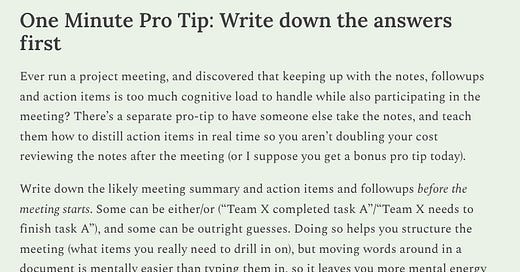Embracing Clarity and Seizing Opportunities
Make the most of your chances by communicating clearly and taking proactive steps
Leadership Moment: Not wasting your shot
“We have a tradition here at BSides Tel Aviv,” Keren Elazari said to me in the green room. “I’ll have a shot with you on stage. It can be before your talk, or after your talk, or whenever. When do you want to do it, and what do you want in your [souvenir] shot glass? It doesn’t have to be alcohol.” I was just about to head onstage to give my Harry Potter talk, and, honestly, it was the last thing on my mind.
“What do you drink? I’ll have that.” What I really appreciated from Keren was the crisp communication: Here’s our tradition. We’d like you to participate. You control the timing, and the beverage.
All too often when we ask people to participate in our culture, we assume that they know everything, and we waste our time and theirs needing to fill in the blanks when misunderstandings arise. You sometimes only get one shot at delivering your message and getting someone on board: make it crisp.
One Minute Pro Tip: Write down the answers first
Ever run a project meeting, and discovered that keeping up with the notes, followups and action items is too much cognitive load to handle while also participating in the meeting? There’s a separate pro-tip to have someone else take the notes, and teach them how to distill action items in real time so you aren’t doubling your cost reviewing the notes after the meeting (or I suppose you get a bonus pro tip today).
Write down the likely meeting summary and action items and followups before the meeting starts. Some can be either/or (“Team X completed task A”/“Team X needs to finish task A”), and some can be outright guesses. Doing so helps you structure the meeting (what items you really need to drill in on), but moving words around in a document is mentally easier than typing them in, so it leaves you more mental energy to listen for truly novel inputs.
Appearances
Recently published
Oped: Why assessing third parties for security risk is still an unsolved problem, CSO Online
Interview: Bishop Fox interview on 1% Leadership at RSAC
Future
July 20: Webinar, The First 91 Days of a CISO’s tenure, with Christina Shannon, KIK
There’s a chance I’ll be in the Canton, OH area the weekend of July 22, if you’re in the area and want me to drop in for an event.
Aug 9/10: Reducing Your Team’s Energy Costs: An Inclusion Microtalk, at Black Hat USA
Sep 20: SANS CISO Roundtable
Interested in having me speak at an upcoming event? Contact me via speakers@duha.co.
Chapter Cameo: Leadership is helping someone become a better version of themselves
I like to think of this chapter (19) as the Development Rule. There are a lot of different flavors of leadership, but core to any form of sustainable leadership is the investment in helping people become better than they were. That might be in core technical skills. You might be developing them in their own leadership skillset, or learning how to manage projects, or just be a better colleague.
The more you’re investing energy in an interaction, the more you should understand how it’s helping the person you’re interacting with. If the other person has made an error, are you engaging in a way that is going to help them do better … or just teach them to avoid you?



